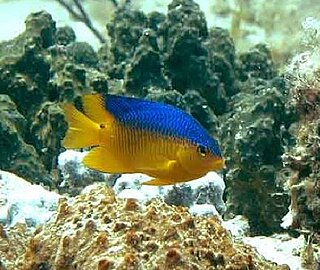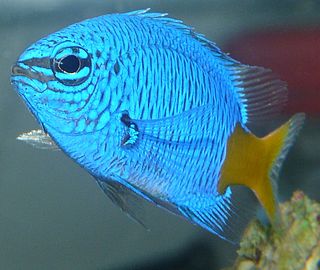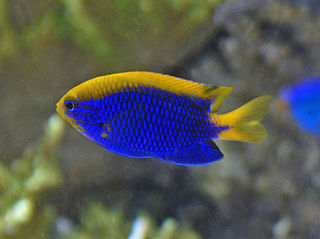
Pomacentridae is a family of ray-finned fish, comprising the damselfishes and clownfishes. This family were formerly placed in the order Perciformes but are now regarded as being incertae sedis in the subseries Ovalentaria in the clade Percomorpha. They are primarily marine, while a few species inhabit freshwater and brackish environments. They are noted for their hardy constitutions and territoriality. Many are brightly colored, so they are popular in aquaria.

The Garibaldi, known historically also as the Catalina goldfish and marine goldfish and now commonly as the Garibaldi damselfish is a species of bright orange fish in the damselfish family. It occurs in the subtropical northeastern part of the Pacific Ocean. The English name, Garibaldi, is based on an Italian surname and is a reference to the Italian general and political figure Giuseppe Garibaldi, whose followers often wore a characteristic scarlet or red shirt. As is the case in all damselfish, male Garibaldis aggressively defend the nest site after the female lays eggs.

Damselfish are those within the subfamilies Abudefdufinae, Chrominae, Lepidozyginae, Pomacentrinae, and Stegastenae within the family Pomacentridae. Most species within this group are relatively small, with the largest species being about 30cm in length. Most damselfish species exist only in marine environments, but a few inhabit brackish or fresh water. These fish are found globally in tropical, subtropical, and temperate waters.

Chrysiptera is a genus of damselfish in the family Pomacentridae.

Chrysiptera cyanea is a species of damselfish found in the wide Indo-West Pacific but not known in the Red Sea. A few individuals were observed in the Mediterranean Sea in 2013 off Slovenia, a likely aquarium release.

Chrysiptera parasema, also known as yellowtail damselfish, yellowtail blue damsel, goldtail demoiselle and other variations, is a popular saltwater species of fish from the Indo-Pacific. It was described by Fowler in 1918.

Dascyllus melanurus, known commonly as the four stripe damselfish, blacktail dascyllus, humbug damselfish, blacktail damselfish, and blacktail humbug, is a species of fish in the family Pomacentridae. It is native to the western Pacific Ocean. It is sometimes kept as an aquarium pet.

Chrysiptera taupou, known commonly as the southseas devil, southseas demoiselle, and Fiji damsel, is a species of damselfish. It is native to the western Pacific Ocean from the Coral Sea to Samoa.

Chrysiptera talboti, known commonly as Talbot's damselfish and Talbot's demoiselle, is a species of damselfish. It is a marine fish from the eastern Indian Ocean and western Pacific.

Chrysiptera hemicyanea, known commonly as the azure damselfish, azure demoiselle, half-blue demoiselle, and yellow-dipped damsel, is a species of damselfish.

Chrysiptera springeri, commonly known as Springer's demoiselle, is a species of damselfish in the family Pomacentridae.

Chrysiptera starcki, commonly known as Starck's demoiselle, is a species of damselfish in the family Pomacentridae. It is native to the western Pacific Ocean, where it has been reported from the Ryukyu Islands and Taiwan to Australia, New Caledonia, and Tonga. It was originally described in 1973 as Abudefduf starcki.

Chrysiptera tricincta, also known as the threeband damselfish and threeband demoiselle, is a species of damselfish in the family Pomacentridae. It is native to the western Pacific Ocean. It reaches about 6 centimeters in length. It has some commercial importance as an aquarium pet.

Neoglyphidodon melas, also known as the bowtie damselfish, black damsel, bluefin or royal damsel, is a species of damselfish found in the Indo-West Pacific. It often makes its way into the aquarium trade. It grows to a size of 18 cm (7.1 in) in length.

The yellowtail damselfish is a species of damselfish native to tropical areas such as the Caribbean coast of Panama. Damselfish are abundant in coral reef environments. The International Union for Conservation of Nature lists this fish as being of “least concern”. The species is exploited on a minor scale, for fisheries and the aquarium trade. It may be threatened by the invasive lionfish.

Stegastes planifrons is a damselfish from the Western Atlantic. It occasionally makes its way into the aquarium trade.
Chrysiptera caeruleolineata, commonly called the blueline demoiselle, is a species of damselfish from the Indian and western Pacific Oceans. It is up to 6 centimeters long.

Chrysiptera rex, commonly known as the king demoiselle, is a species of damselfish in the family Pomacentridae. It is native to the eastern Indian Ocean and western Pacific, where it lives around reefs. It grows up to 7 centimetres long. It is of commercial importance in the aquarium trade.

Chrysiptera rollandi, commonly known as Rolland's demoiselle, is a species of damselfish in the family Pomacentridae.

Chrysiptera brownriggii, commonly known as the surge damselfish, is a species of marine fish. It is widespread in Indo-Pacific waters from East Africa to the Marquesas Islands and Society Islands, north to Japan and south to Australia. Its common name arises because it is associated with the rubble in channels created by tidal surges in reefs, but it is also found on reef flats and submerged terraces. It is territorial but is frequently encountered in groups. The identity of the person honoured by the specific name was not stated by Bennett in his original description but it is almost certainly Robert Brownrigg (1759-1833) who was governor of Ceylon where the type was collected.

















